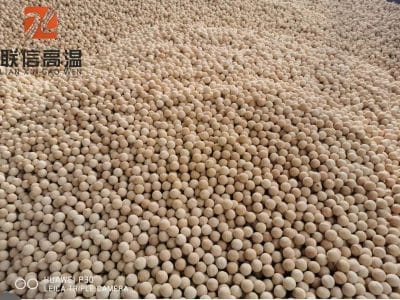Refractory balls are mainly used in fertilizer plants, steel industry, sulfuric acid and fertilizer industry, etc. Its characteristics include high temperature resistance, high strength, stability, etc.

Refractory balls
Uses of refractory balls:
Wide application in fertilizer plants:
Refractory balls are widely used in fertilizer plants, especially in high and low temperature conversion furnaces, converters, hydrogenation converters, desulfurization tanks and methanation furnaces. In these equipment, refractory balls mainly play the role of dispersing gas and liquid, supporting catalysts, and also covering and protecting catalysts.
The use of refractory balls has greatly improved the production efficiency of fertilizer plants and the service life of catalysts. Especially in an environment with frequent high and low temperature changes, refractory balls can maintain the stability of physical and chemical properties, and effectively avoid catalyst damage caused by temperature fluctuations.
Application in the steel industry:
In the steel industry, refractory balls are widely used in hot blast furnaces and heating conversion equipment. They not only play the role of heat transfer and heat storage, but also help to achieve material processing at high temperatures, improving energy utilization efficiency and production efficiency.
Refractory balls help stabilize furnace temperature in hot blast furnaces by storing and releasing heat energy, thereby optimizing production processes and improving steel quality.
Applications in sulfuric acid and fertilizer industries:
In sulfuric acid and fertilizer industries, refractory balls are mainly used in key equipment such as converters and conversion furnaces. The refractory balls in these equipment must not only have high temperature resistance, but also be able to resist chemical corrosion and physical wear to ensure the continuity and safety of the production process.
The use of refractory balls can effectively reduce the number and cost of equipment maintenance, extend the service life of the equipment, and thus improve the economic benefits of the entire production line.
Other industrial applications:
In addition to the above industries, refractory balls are also used in a variety of other industrial equipment, such as heating furnaces and desulfurization tanks. These applications illustrate the excellent performance of refractory balls in high temperature and harsh environments.
The spherical design of refractory balls allows them to effectively disperse airflow in reactors or furnaces, reduce the impact on catalysts, thereby optimizing the reaction process and improving the quality of products.
Features of refractory balls:
Extremely high temperature resistance:
Refractory balls can withstand temperatures up to 1900 degrees, which makes them very suitable for use in extreme high temperature conditions, such as in various high temperature furnaces and reactors in fertilizer plants and the steel industry.
This high temperature resistance is possible mainly because refractory balls are made of high temperature materials such as industrial alumina and refractory kaolin, which can remain stable in high temperature environments.
https://youtube.com/shorts/v3G2IGVRzok?feature=share
High strength and good mechanical properties:
Refractory balls have very high mechanical strength, which enables them to be used in environments that are subject to great physical shock and pressure, such as in moving beds and fluidized beds.
This high strength ensures that refractory balls are not easy to break or damage during long-term use, reducing replacement frequency and maintenance costs.
Excellent chemical stability:
Refractory balls do not react chemically with materials, and can maintain stable physical and chemical properties even in complex chemical environments, which is particularly important for protecting catalysts and ensuring product quality.
This stability means that refractory balls will not reduce their performance or life due to chemical reactions with materials, ensuring long-term use effects.
Thermal shock stability and low re-burning shrinkage:
Refractory balls can withstand rapid temperature changes without breaking, which is very important in industrial environments with large temperature fluctuations.
The low re-burning shrinkage ensures that the ball size remains stable under long-term high temperature without affecting its performance and service life.
Significant heat storage and thermal conductivity:
Due to their special material and structure, refractory balls have good heat storage and thermal conductivity, which makes them perform well in applications that require rapid heating or cooling.
This performance not only improves the thermal efficiency of industrial furnaces, but also helps energy conservation and emission reduction, in line with current sustainable development requirements.
With the advancement of technology and changes in the market, refractory balls may face new challenges and opportunities in the future. On the one hand, with the strengthening of environmental protection regulations and the increase in industrial demand for high-efficiency and energy-saving materials, the market demand for refractory balls is expected to continue to grow. On the other hand, with the development of new materials and new technologies, how to further improve the performance of refractory balls and reduce costs has also become a key direction of research and development.
In general, refractory balls play an important role in multiple industries with their unique characteristics, not only improving production efficiency, but also bringing significant economic and environmental benefits. In the future, refractory balls will continue to be one of the indispensable and important materials in many industrial fields.
